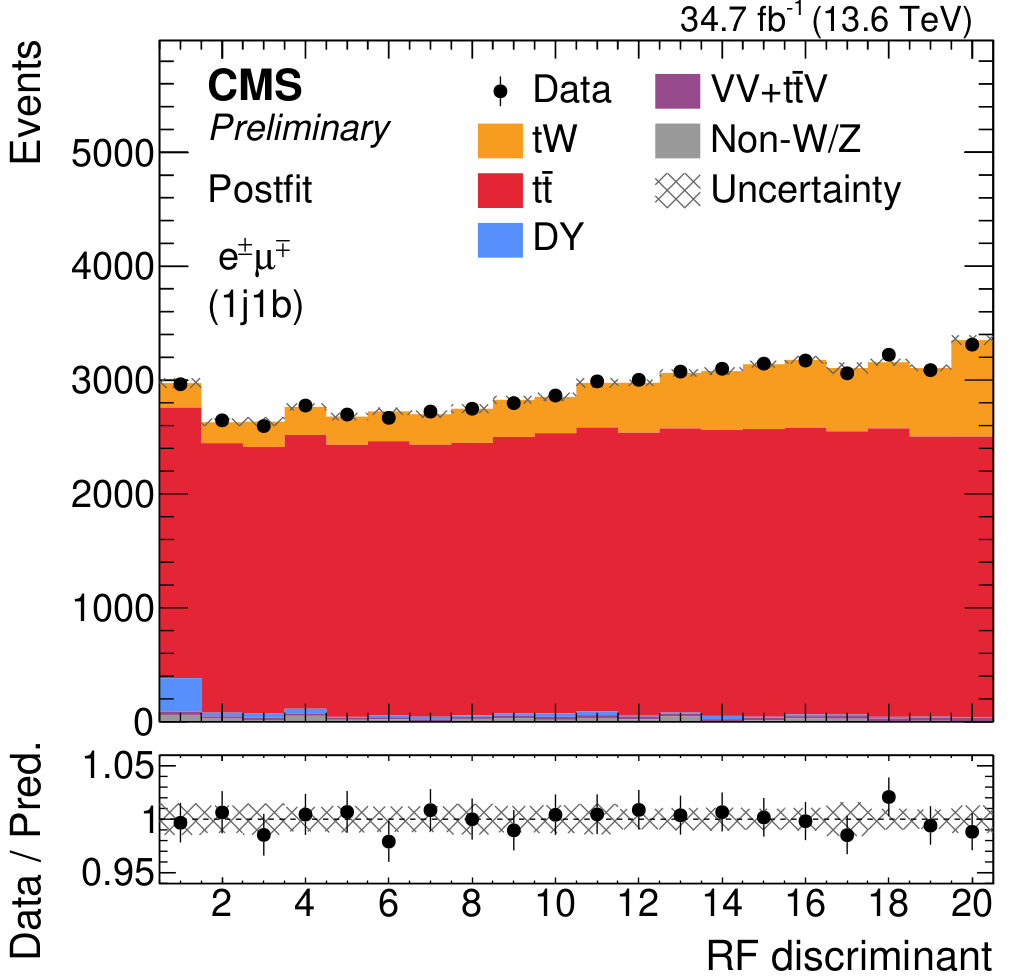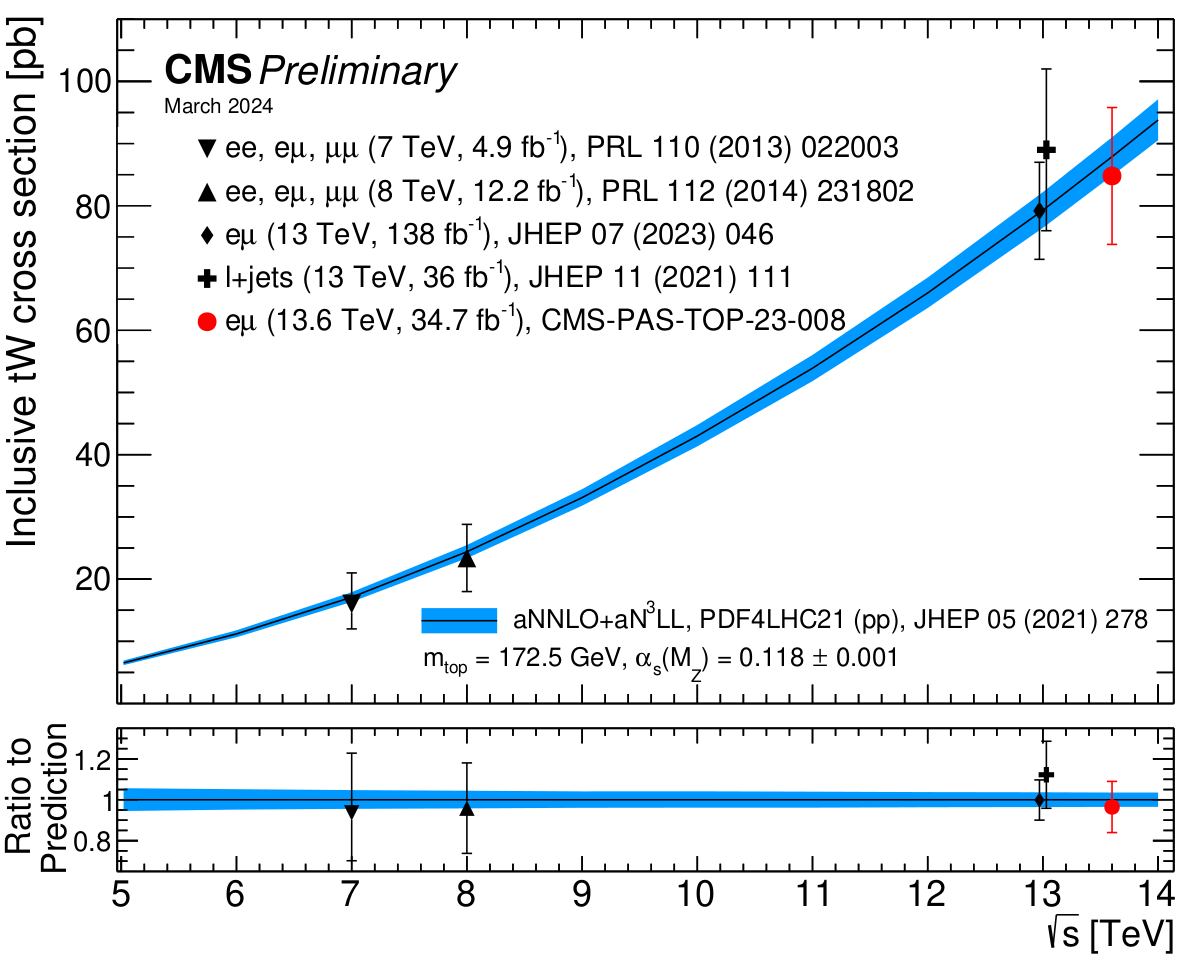
Back in September 2022, four months after the start of the LHC Run 3, the CMS collaboration released the first measurement using data at the new collision energy of 13.6 TeV. Using the data recorded only in two months – less than 1% of the LHC goal for the entire Run 3 operation – CMS measured the production cross section (production rate) of a top quark together with its own antiparticle (the top antiquark). Being the most massive known particle, top quarks continue to be an area of focus for precision measurements and searches for new phenomena. At the LHC, they are copiously produced in pairs (tt), and in single modes to a much lesser extent. Single top quarks are produced via electroweak interactions. Therefore, the precise measurement of the single top cross section provides a stringent test for the electroweak nuclear force, a core part of the Standard Model of particle physics (SM).
Now, more than a year after the measurement of the tt cross section in Run 3, CMS measured the cross section for single top quark production in association with a W boson (tW). This is a challenging measurement for several reasons: it's a rare process (10 times less likely than tt production), it has an almost similar experimental signature to that of the main background, and it requires an in-depth understanding of the detector performance given the complex final states being considered (obtaining detailed calibrations requires a non-negligible effort and time).
The recently reported measurement was based on the full dataset recorded in 2022. It was presented at the Moriond Electroweak conference by Alejandro Soto, a PhD student from ICTEA-University of Oviedo, who worked in the analysis. Both the top quark and the W boson in the tW event are considered to ultimately decay to leptons. The signal signature therefore consists of two leptons (electrons or muons), a jet initiated from a bottom quark, and possibly extra jets coming from additional radiation. As mentioned above, there is no single observable that can provide discrimination power between signal and background. Therefore, a Random Forest (RF) – a widely used machine learning algorithm – is employed in events that contain either one or two jets, of which one is initiated from a bottom quark. The RF is a collection of decision trees collaborating to distinguish the tW signal from the tt background. By merging the predictions of the individual trees, the model determines the most frequent class (for classification) or the average prediction (for regression), thereby refining the accuracy and preventing overfitting. The output of the RF for events with one jet identified as coming from a bottom quark is shown in Fig. 1. The tW events tend to populate the high score region while background events populate the low score region, providing the means to discriminate the signal from the overwhelming tt background.

Figure 1: Distribution of the output of the Random Forest for events with one jet identified as coming from a b jet.
Aiming at a better precision, we use an extra handle in the data to control the tt background. This is achieved by including information in our measurement from events with two b-quark jets. Such events are more likely to come from the decay of a tt pair. The measurement yields a precise value for the tW cross section in proton-proton collisions of 13.6 TeV centre-of-mass energy. Figure 2 shows the tW cross section measurements by CMS at different centre-of-mass energies, in agreement with state-of-the-art theory calculations. The first tW measurement at the new energy frontier uses only part of the data and is as precise as the one using the entire data of LHC Run 2. Performing the measurement on the full LHC data sample of Run 3 will push the precision frontier forward and provide an even more stringent probe for the SM in the top quark sector.

Figure 2: tW production cross sections measured by CMS at four centre-of-mass energies. The red circle represents the measurement using data taken during Run 3 at 13.6 TeV. All the measurements are in good agreement with the theoretical prediction.
Read more about these results:
-
CMS Physics Analysis Summary (TOP-23-008): "Measurement of inclusive and differential cross sections for single top quark production in association with a W boson in proton-proton collisions at 13.6 TeV "
-
Display of collision events: CERN CDS
-
@CMSExperiment on social media: LinkedIn - facebook - twitter - instagram

